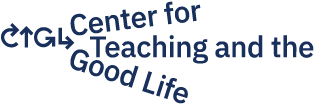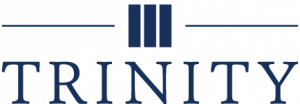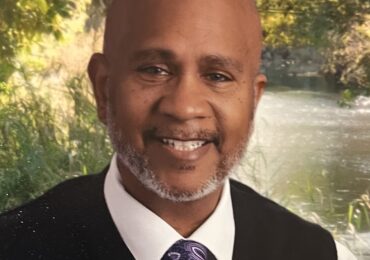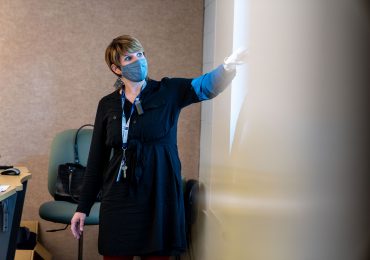The COVID-19 pandemic created a VUCA world: Volatile, Uncertain, Complex, and Ambiguous (Hadar, et.al., 2020). In this world, many of our students have struggled with lack of control, helplessness, overload, and lack of clarity. At the beginning of the pandemic, we sent students home and switched to remote instruction. When we brought them back to campus, some classes were remote while others were a hybrid of in-person and remote instruction. We have all had to make a lot of adjustments.
I teach the Professional Seminar for Chicago Semester education students. When we moved to remote learning in the spring of 2020, I switched to the flipped classroom approach, and I found it to be so effective for student learning that I continue using it even after returning to fully in-person instruction.
So, what is a flipped classroom, how does one set up a flipped classroom, how does one use the flipped classroom, and why do I continue to use a flipped classroom?
What is a flipped classroom?
While a flipped classroom may be fairly new to many, this approach has been used for years, notably within the humanities. Walvoord and Anderson promoted the use of this approach in their 1998 book Effective Grading (cited in Brame, 2013).
When I first heard of a flipped classroom, it was connected with online learning and then with remote learning, but that was not the original purpose of this approach. According to Talbert (2020), a flipped classroom is about making the most of the time instructors and students have together. It requires us to consider what students are going to do while we are together, and consequently what they are going to do when we are not together.
Flipping the classroom means that students are introduced to new material outside of class, usually via readings, videos, or websites, and spend time focusing on the processing part of learning (synthesizing, analyzing, problem-solving, etc.) in class. Despite what we may have been led to believe, the flipped classroom can be used anytime, not just with online or remote learning.
How does one set up a flipped classroom?
The article “Flipped Classrooms” suggests that instructors use the following steps to implement this approach:
- Determine how much time the students should spend on the assignment each week. Since students’ in-person course time is reduced, the out-of-class preparation time can be increased.
- Find or create resources for students to use at home. These may include readings, audio files, websites, or videos.
- Design assignments using those resources.
- Establish how the instructor can efficiently assess the assignment and gather information to plan class activities.
- Decide how to use class time, and develop activities for that time. (A flipped classroom model involves more work by students outside of class, and they will resent this work if they do not see how it frees class time to do things that help them learn.)
How does one use the flipped classroom?
When Chicago Semester switched to remote instruction, our course meeting time was reduced from 2 hours to 1 hour to minimize Zoom fatigue. To ensure that the students were prepared so they could be actively engaging during class, assignments were due in advance of the class. When we returned to in-person classes in the fall of 2020, we sought to limit the time spent face-to-face to minimize exposure to covid-19. Using the flipped classroom made it possible to reduce the in-person class to 60 minutes for discussion and 15 minutes for debriefing. We used Brame’s (2013) four key elements of the flipped classroom:
- Provide an opportunity for students to gain first exposure before class.
I assign students articles to read, videos to watch, and/or websites to explore. I share these assignments and materials with students one week in advance. In addition to answering the assigned questions, students are asked to pose questions for in-class discussion.
- Provide an incentive for students to prepare for class.
Students submit weekly assignments by Sunday night. On Monday, I review the assignments and score them on a 4-point scale. This provides an incentive for students to complete the assignments, which prepares them for in-class discussion on Tuesday.
- Provide a mechanism to assess student understanding.
I make note of outstanding student answers and the questions students struggled with to be shared in class. This information, along with the questions the students posed, is used to plan the next day’s lesson. It is not necessary to provide extensive written feedback, since students will receive productive feedback through in-class activities.
- Provide in-class activities that focus on higher-level cognitive activities.
I clarify anything students struggled with and ask specific students to share their responses to selected questions. I then give students questions to discuss as a class or in small groups and sometimes introduce supplementary materials. The key is that students are using class time to deepen their understanding and increase their skills in using newly obtained knowledge. They are also building a social support system with their peers as they discuss and problem-solve together.
Why do I continue to use a flipped classroom?
While I switched to the flipped classroom to adapt to the challenges brought about by covid-19, I chose to continue using the approach for the following reasons.
- Individualization. As Christian educators, we rejoice in the uniqueness of each student and seek ways to make learning accessible to all. A flipped classroom allows students to fit the learning process to their personal needs and learning styles, including preferences in terms of study time, place, and pace. Students with diverse levels of pre-existing knowledge have the opportunity to get to the same level before entering class and be better prepared to engage in higher-level learning (Goedhart, et. al., 2019).
- Increased learning. Students engage in lower levels of cognitive work, such as gaining knowledge and comprehension, outside of class and focus on the higher forms of cognitive work in class. Students have the opportunity to use their new factual knowledge during class while they have access to immediate feedback from peers and the instructor. This makes it easier for students to correct misconceptions and organize new knowledge so that it is more accessible for future use (Brame, 2013). Scenarios and challenging questions introduced during class stimulate discussion and provide opportunities for students to engage in problem-solving and increase their understanding of concepts (Rhea, 1999).
- Collaboration. Gen Z students learn by doing and prefer an active and collaborative learning environment (Hayde, 2017). They put a high value on face-to-face interaction and group learning (“They’re Coming”). In a flipped classroom, students have increased opportunities to interact, be proactive, and address issues they are facing in the school setting. Increased collaboration among students builds trust, confidence, and coping skills, while also decreasing mental exhaustion (Rhea, 1999).
- Instructor satisfaction. Since I review student assignments before class, I can tailor discussions and activities around concepts students need more help understanding and issues in which they are most interested. Because I work more closely with students, I get to know them better and can provide individualized guidance and support. When students are prepared for class, there is more interaction, and we all enjoy class more.
- Student feedback. When asked at the end of the semester to describe how a flipped classroom model impacted their learning, students responded positively. Comments include:
- “I enjoyed this model because we were all prepared and ready for any questions or specific topics we wanted to discuss later.”
- “It was good to come to class and talk with other students and hear their thoughts and experiences.”
- “I love the flipped classroom. It gave me a chance to work on assignments at my own pace before it was due. It makes me feel more prepared for when we meet face to face.”
I have chosen to continue to use a flipped classroom because I believe it is the best way to respect my students’ time and allows them to learn in ways that fit their styles and schedules. It increases student learning and gives students opportunities to collaborate with peers and me as their instructor. We all enjoy class more with this approach!
REFERENCES
Brame, C. (2013). Flipping the Classroom. Vanderbilt University Center for Teaching.
https://cft.vanderbilt.edu/guides-sub-pages/flipping-the-classroom/
Flipped Classrooms (n.d.). Harvard University: The Derek Bok Center for Teaching and Learning.
https://bokcenter.harvard.edu/flipped-classrooms
Goedhart, N.S., Blingnaut-van Westrhenen, N., Moser, C., & Zweekhorst, M.B.M. (2019, March 7). The Flipped Classroom: Supporting a Diverse Group of Students in Their Learning. Learning Environments Research, 22, 29-0310.
DOI.org/10.1007/s10984-019-09281-2
Hadar, L.L., Ergas, O., Alpert, B. & Ariav, T. (2020) Rethinking teacher education in a VUCA world: student teachers’ social-emotional competencies during the Covid-19 crisis, European Journal of Teacher Education, 43:4, 573-586.
https://www.tandfonline.com/doi/full/10.1080/02619768.2020.1807513
Hayde, K. (2017, August 8). Gen Z and the Flipped Classroom. Macmillan Community.
https://community.macmillanlearning.com/t5/stem-blog/gen-z-and-the-flipped-classroom/ba-p/5933
Rhea, D.J. (1999). Proactive Seminars for Student Teachers. Journal of Physical Education, Recreation & Dance, 70:8, 46-49. https://www.tandfonline.com/doi/abs/10.1080/07303084.1999.10605707
Talbert, R. (2020, November 6). The Unreasonable Effectiveness of Flipped Learning in Pandemic-Era Higher Education.
https://rtalbert.org/unreasonable-effectiveness-flipped-learning/
They’re Coming: Rethinking and Development for Generation Z. (2020, January 16). Panopto.
https://www.panopto.com/blog/rethinking-training-and-development-for-generation-z/

Lisa Hensey, Ph.D., is Education Program Director at Chicago Semester. She is an alumnus of Illinois State University (B.S.) and The University of Iowa (M.A. & Ph.D.) and a former junior high teacher and Assistant Professor at Mount St. Clare College. Prior to joining Chicago Semester, Lisa developed a secondary education program at Tumaini University, Iringa University College in Tanzania.










